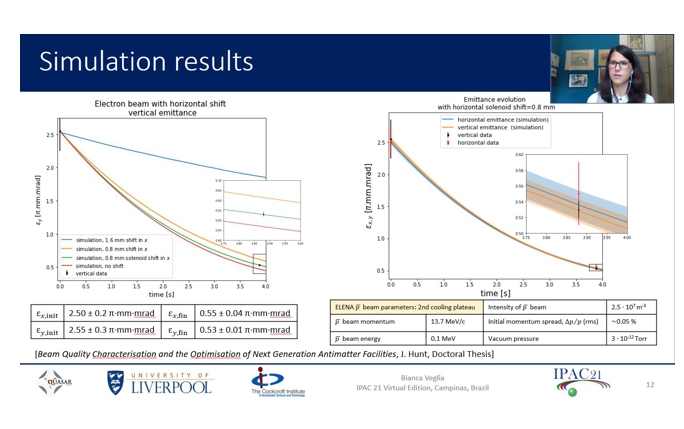AVA Fellow Bianca Veglia presented at IPAC'21

AVA Fellow Bianca Veglia was selected to give a contributed talk at the 12th International Particle Accelerator Conference – IPAC’21. The conference was organized by the Brazilian Center for Research in Energy and Materials (CNPEM), Campinas (Brazil), and took place online 24-28 May. IPAC is the main international event for the worldwide accelerator community and industry. Attendees are presented with cutting-edge accelerator research and development results and gain the latest insights into accelerator facilities across the globe.
Based at the Cockcroft Institute/University of Liverpool (UK), Bianca has been studying antimatter experiments on beam stability and life time in low energy storage rings. Within her AVA project, Bianca developed realistic models for beam transport, storage, deceleration and cooling from storage rings through beam lines to experiments.
On receiving the invitation to speak at IPAC’21, Bianca said: “I was thrilled to be asked to give a contributed talk at this year’s (unfortunately again) virtual IPAC. It is the largest accelerator physics conference and definitely the widest audience I ever had to give a talk to. So my excitement was also accompanied by some hints of terror. I heard somebody saying in a movie once: ‘The number one fear of people isn’t dying, it is public speaking’. For this, the virtual format makes it a bit easier, even if it meant that I had to endure the intense pain of watching myself over and over trying to present my slides.”
Oral presenters were required to prerecord their talk which was then made available online (it still is, actually) for participants to watch at their convenience, as the conference covered all time zones from Tokyo (Japan) to Campinas (Brazil) and San Francisco (USA). Bianca’s talk titled The Effect of Electron Beam Velocity Distribution on Electron-Cooling at ELENA focused on electron cooling dynamics for the Extra Low Energy Antiproton (ELENA) ring, specifically the effect of different electron beam distributions and cooler geometry imperfections on the antiproton beam evolution.
The talk presented simulation results of a dynamic model for the ELENA electron cooler using an accurate description of the cooling process based on realistic distribution of electrons. For this study, BETACOOL simulations of the ELENA antiproton beam phase space evolution were performed using uniform, Gaussian and “hollow beam” and parabolic electrons velocity distribution. Unfortunately, it is impossible to have a direct observation of the electrons inside the cooler. Therefore, G4beamline was used to simulate the interaction of an initially Gaussian electron beam with the magnetic field measured inside the electron cooler assembly: a transverse shift of the center of the electron distribution along the cooler interaction chamber was observed. Introducing this misalignment in the simulations, interpreted as a geometry imperfection of the drift solenoid, a very good agreement with measured data was found, validating the model.
On presenting her talk, Bianca said: “I was broadly satisfied with the outcome: I received some nice feedbacks and was involved in very interesting discussions that ultimately helped me to progress with my thesis. Often the eye of somebody not involved in the project can help to observe the subject from a new perspective and suggesting new approaches. For sure the distressing time I used to prepare was well spent and I really hope to have the chance to present at this fantastic conference again in the future, possibly in front of a live audience.”
For anyone who has registered for IPAC’21, a video of Bianca’s presentation can be viewed via this link.